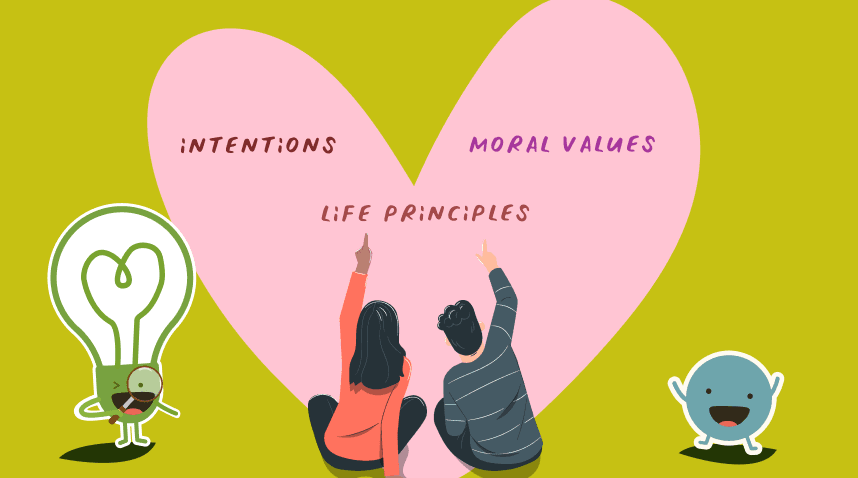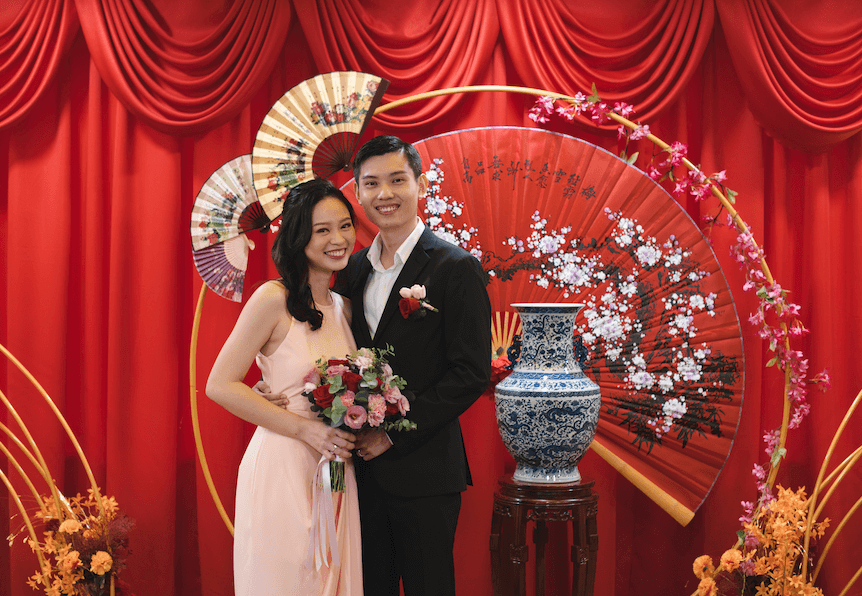TLDR: We naturally seek a spouse who is physically, emotionally and spiritually compatible. However, compatibility may not need to be rigid definitions. Sometimes, we fall in love with people that we think are religiously incompatible. Ze Wen shares his experience (not dating advice) on how he navigated his journey of introducing Buddhism to his non-Buddhist spouse and in-laws.
“What are your requirements for a partner?”
“She needs to be a Buddhist,” I replied.
I grew up listening to stories of familial relationships that turned sour because of different religious beliefs. I never expected to end up in an interfaith marriage.
Years ago, my opinions were more absolutist, thinking that it was nigh impossible to live the rest of my life with someone who didn’t share similar spiritual views as I did. I imagined the insurmountable conflicts and effort we would go through in our daily interactions; with our families, friends and the community.
All that changed after I met my spouse.
While I wouldn’t dare deny that affection made me reconsider my stance, there was plenty to learn about my own seemingly non-negotiable beliefs. What exactly made me think that non-Buddhists were incompatible life partners?
I listed some methods that helped me change my perspectives, and subsequently introduce Buddhism to my spouse.
Investigate

The first step was to ascertain that my partner was spiritually and morally compatible to a certain degree. I knew that we were of different faiths even before we dated. This made me doubt whether our relationship would work or not. After thinking about the various differences in our spiritual beliefs and how it was an obstacle to me, I recalled the Discourse on Highest Blessings, Maha-mangala Sutta[1] . There, the Buddha exhorted that it is a great blessing to associate with the wise, and disassociate with the foolish.
By no means the Buddha meant that non-Buddhists were all fools! [2] The Dalai Lama himself had a close friendship with the late Archbishop Desmond Tutu. This was where I had to reflect on the definition of “wise” and “foolish”. According to the Buddha, there is a simple metric to identify the fools and the wise – the wise see transgressions as transgressions, and pardons another for confessing their transgressions.
This led me to reflect that it wasn’t our religious beliefs that made one “wise” or “foolish”, “wholesome” or “unwholesome”. Rather, our moral values, life principles and intentions are much better determinant factors. For this, the Kalama Sutta is another resource that helps discern between “wholesome” and “unwholesome” qualities that are in line with Buddhist values.
As I got to know her better, I was elated to find out that she was someone who was responsible, would go out of her way to help those in need, and had a soft spot for animals! She was also accepting of Buddhism, as she grew up learning Buddhist values in Tzu Chi as a child before being baptised.
Thanks to this, her family also had a favourable view of Buddhism. It was crucial to ascertain her family’s initial stance on Buddhism, as it would form the basis of my approach to communicating my personal practices to them.

Communicate
During my early dating days, I gently but sincerely explained to my spouse that I would maintain a lifestyle that was in line with Buddhist principles: dana (generosity), sila (moral precepts) and bhavana (mental cultivation). I explained mostly the part of the Five Precepts, as non-Buddhists may not be familiar with them. These are:
i) Abstaining from killing living beings.
ii) Abstaining from taking things not given.
iii) Abstaining from sexual misconduct.
iv) Abstaining from false speech.
v) Abstaining from consuming intoxicants (recreational drugs and alcohol).
Although they may seem like common sense, I realise that many non-Buddhists do find it peculiar to abstain from killing insects (First Precept), telling white lies (Fourth Precept) and drinking alcohol (Fifth Precept)! So, I focused on explaining these three precepts to my spouse.
First Precept
For the First Precept of abstaining from killing, I explained that respect towards all forms of life, even for animals and insects, helps cultivate a life of non-harm and loving-kindness (metta). This precept lets us be a safe refuge for ourselves and the people around us, which protects those close to us, such as our spouses and family members.
I shared with my partner my personal experiences relating to insects, especially cockroaches. As a child, I had no qualms about killing small insects around the house.
Over the course of several years of upholding the First Precept, I was able to observe how my fear and aversion of cockroaches gradually subsided from mindless panic, to grudging avoidance, to mindful acceptance now. Of course, it is a work in progress; the flying ones still terrify me!
Second Precept
For the Fourth Precept of maintaining truthful and wholesome speech, I shared with my partner that it inculcates a habit of responsibility within us, for it will make us more mindful of our statements and promises. Besides that, upholding kind and wholesome speech habits also enforces the habit of non-harm and compassion (karuna).
Not saying white lies is another frequently disputed topic about the Fourth Precept. I explained that although the intentions behind a white lie may be to alleviate suffering or to help somebody, it is still ultimately a form of deceit.
Once the truth unfolds, the trust and faith that others have in us could be irreparably compromised. Furthermore, even telling white lies will give us a subconscious habit and acknowledgement that it is okay to lie, giving leeway to a looser tongue.
I also explained that in a world where fake news runs rampant and people are becoming more vocal and visible with their views, it is more important than ever to know how to express ourselves truthfully in skilful ways that are non-confrontational.
Fifth Precept
To me, justifying the Fifth Precept (abstaining from intoxicants) was the most challenging to me. Many would argue that drinking a little bit of alcohol wouldn’t muddle the mind and that it is important to socialise.
Nowadays, I explain to curious folks that it is a matter of personal choice and principle. I further elaborated to my spouse that I take this precept as a disciplinary practice. Although I may still retain my mindfulness and composure after a few sips of alcohol, even a slight compromise of this precept may lead to intentionally breaking all precepts.
However, we had to define how to work around upholding this precept, as it may inconvenience the people around me. For example, my mother-in-law likes to cook drunken chicken, and while I also have explained my precepts to her, she may not choose to practise it. Hence, whenever it is respectful, I do consume food that incorporates alcohol in it, but I draw the line at drinking beverages that contain alcohol.
Also, I did not impose any of these precepts upon my spouse. After all, it is important to not demand the understanding of others upon our own personal practices but rather to explain the reasoning of our stances to encourage acceptance towards our personal practice and motivations.
After explaining the Five Precepts to my spouse, she was also able to accept and accommodate them. This was also helped by the fact that she had been exposed to Buddhist values at a young age. Now, instead of killing insects, she lets me catch and release them!
Explaining the precepts clearly was an important skill for me to cultivate, so that my partner could communicate this to her family to allay any doubts or concerns they have about having an in-law from another faith.
One example of communication would be whether my family would need my spouse to conduct ancestor worship. I assured them by explaining that we offered food to my ancestors as a token of respect and gratitude and practising compassion to alleviate their suffering by transferring merits.
Accommodate


I wanted to introduce my spouse and her family to an accurate understanding of Buddhism. However, being too direct may lead to defensiveness and apprehension.
So I began by accommodating her personal beliefs and religious family traditions. I attended a few church masses with my spouse and her family. Truthfully, I felt out of place.
Engaging with people there didn’t help me feel better. Some conversations made me feel there were expectations upon me to convert to their faith because of my relationship with my spouse.
Although I felt discontent arise within me, I knew that they only had the best interests of the family’s harmony at heart.
In order to overcome the discontent, I reflected that if the roles were reversed, I would also similarly want to welcome another community member into my own faith. With sympathetic joy (mudita) and mindfulness of my own emotions, I was eventually able to come to terms with the church-goers’ expectations, and accept them with equanimity. However, I still do find myself at a loss for words whenever they directly ask me when would I convert my faith!
In return, my spouse and her family were open to me bringing her to attend Dhamma talks. We visited a few temples and centres, and she also attended regular online services together with me during the COVID-19 lockdowns.
I was happy my partner even showed interest by asking me questions after the Dhamma talks! In time, even my mother-in-law began to ask for beginner resources for introduction to Buddhism, so she could understand it at her own pace. For her, I passed the book “What Buddhists Believe” by the late Ven. K. Sri Dhammananda to her, which was ideal for anyone who wants to know more about Buddhism from an outsider’s perspective.
Demonstrate
Being open to experiencing my spouse’s culture and religion helped reassure her family that I wasn’t spiritually imposing nor demanding of them. However, it isn’t enough to introduce them to Buddhism. More effort needs to be taken to demonstrate Buddhist principles and practices in a non-directive way.
As expounded in the Kalama Sutta, emulating the values of goodwill, appreciation, humility, compassion and equanimity leads to welfare and happiness. Embodying these values in simple acts such as helping out with the house chores and practising mindful speech and actions will go a long way in fostering intrigue and admiration for Buddhistic values.
As an added benefit, I noticed that demonstrating consistent spiritual ethics over time helps to disarm her peers and family members from suggesting I convert from my faith to theirs.
Initiate
I initiated opportunities to introduce Buddhism to her family only after I felt there was enough familiarity and rapport with them. I mentioned the lessons I learnt from Dhamma talks when I stated the basis of my opinions. When Wesak Day drew near, I would verbally share my practices and the significance behind taking the Eight Precepts, which builds on the Five Precepts I had explained to my spouse.
The opportunities to share specific discourses were rare, but eventually, I even brought my spouse to Buddhist temples and centres to attend Dhamma talks and Sunday Service.
Compromise

We sat down at the beginning of our relationship and discussed some of the things that we foresee could potentially be an issue in the future. Unsurprisingly, the nature of our interfaith relationship became a topic of our discussion.
First, we discussed each other’s expectations of conversion. Since her childhood, my spouse had the notion that in order to maintain marital harmony, she would need to compromise and convert to her husband’s faith upon marriage. I understood where she came from because both of us have witnessed conflicts in marriages where partners had differing religious beliefs on the concept of personal salvation.
With regard to personal salvation, both of us believe that a person’s decency is defined by his/her/their deeds and intentions more than his/her/their religious beliefs. This belief stemmed from our observations of seemingly “pious” people contradicting their religious values by behaving in amoral ways outside the religious institute.
While I welcomed her intention to follow my faith, I explained to her that I viewed religion as a personal choice and I had no intentions nor expectations for her to convert simply because of marriage. In turn, she also was able to view Buddhism as a liberal practice that emphasised personal moral cultivation, rather than compliance and obedience.
Next in our discussion of maintaining an interfaith marriage was the topic of having children. Some faiths encourage having children, yet both of us shared the same view that it should be a personal choice, instead of one dictated by religion or social pressures.
If we were to have any children, they would be free to decide whichever faith they wanted to choose, as long as they had a clear idea about the tenets of that faith. This was because we were also brought up in families where we were given the freedom to choose our spiritual path.
Last but not least, we discussed the wedding rituals. As we had friends and family from different faiths, we decided that our wedding would need to be as neutral as possible in order to be fair to each side. This decision was conveyed to our parents, and we were blessed with their support for our decision. Besides being respectful, obtaining the blessings of our parents in this matter was important for another reason — they were the main channel of communication with our relatives. We had relatives who wanted us to go through a church wedding, but our parents helped behind the scenes to allay their concerns.
Thus, we had to go out of our way to search for non-religious marriage counselling sessions, instead of the readily available Christian ones from her church. Both of us also had to give up our initial wedding dreams. She had to forgo her dream of a church wedding, and I had to compromise on having a Buddhist-themed one. Instead, we opted to solemnise our marriage according to Chinese cultural traditions.
I’d like to share another example where I wanted to find a place to place a Buddha-rupaṁ (Buddha statue) at our rented unit. I realised that although my spouse would not outwardly disagree with me displaying it, it would still symbolise a physical display of my faith in our residence. Understanding how it may cause discomfort with my spouse’s religious orientation, I instead obtained her consent to place the Buddha-rupaṁ in an unassuming manner.
Reflection

Like any relationship, differences between our views and beliefs will arise occasionally. I found that adopting the methods above helped greatly to reduce conflicts and to introduce Buddhism to my spouse and her family. The methods of investigating, communicating, accommodating, demonstrating and compromising are all essential and need to be adopted concurrently.
Moreover, the crucial elements that allowed me to apply them were alertness of my state of mind (sampajañña) and patience (khanti). Without alertness and patience, I would not be able to accept different views with an open mind.
The universal qualities of the Dhamma are not exclusive to Buddhists and are accessible also to anyone from any faith. I am beyond grateful that I chanced upon someone who accepts and encourages the practice of wholesome qualities found in Buddhism.
This marital journey has made me revise my views on interfaith relationships. I used to think that I would remain single until I met another compatible Buddhist. Yet, the moral values and personal qualities that my spouse exhibited were so compatible with mine, that it made me challenge my own views on the basis of this former requirement. Interacting with my spouse made me clarify my own views on what constitutes a “wise” individual from a “fool”.
The occasional discontent or little moments of realisation that I have mentioned before allowed me to proactively cultivate loving-kindness (metta), sympathetic joy (mudita) and equanimity (upekkha). As a result, I am now more understanding and accepting of differing beliefs and views. This whole experience made me and my spouse critically reflect on our beliefs, which has led to an even richer spiritual experience for both of us.
Wise Steps
● Most of us have preconceived ideal criteria for our life partners. Carefully reflect on these criteria. How many of them are genuinely grounded on the principles of the Dhamma?
● Our practices and views may start off as foreign to our spouse, his/her spouse’s family and communities. This is natural. We can learn to investigate, communicate, accommodate, demonstrate and compromise. Patience, acceptance and understanding are all essential to foster harmony in an interfaith relationship.
● At times, it may be necessary to agree to disagree on certain views with our spouse or in-laws on religion and practices. Don’t be disheartened at the practice. Keep on at it consistently, gently and diligently.


